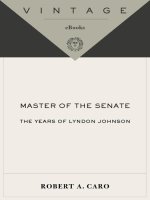Barbara w tuchman a distant mirror the calamito ury (v5 0)
Bạn đang xem bản rút gọn của tài liệu. Xem và tải ngay bản đầy đủ của tài liệu tại đây (8.7 MB, 615 trang )
By Barbara W. Tuchman
BIBLE AND SWORD (1956)
THE ZIMMERMANN TELEGRAM (1958)
THE GUNS OF AUGUST (1962)
THE PROUD TOWER (1966)
STILWELL AND THE AMERICAN EXPERIENCE IN CHINA (1971)
NOTES FROM CHINA (1972)
A DISTANT MIRROR (1978)
PRACTICING HISTORY (1981)
THE MARCH OF FOLLY (1984)
THE FIRST SALUTE (1988)
A Ballantine Book
Published by The Random House Publishing Group
Copyright © 1978 by Barbara W. Tuchman
Maps copyright © 1978 by Anita Karl
All rights reserved.
Published in the United States by Ballantine Books, an imprint of The Random House Publishing Group, a division of
Random House, Inc., New York.
Ballantine and colophon are registered trademarks of Random House, Inc.
This edition published by arrangement with Alfred A. Knopf, Inc.
www.ballantinebooks.com
Library of Congress Catalog Card Number: 79-88536
eISBN: 978-0-307-79369-0
v3.1
Contents
Cover
Map
Other Books by This Author
Title Page
Copyright
Dedication
Acknowledgments
Maps and Illustrations
Foreword
Part One
1. “I Am the Sire de Coucy”: The Dynasty
2. Born to Woe: The Century
3. Youth and Chivalry
4. War
5. “This Is the End of the World”: The Black Death
6. The Battle of Poitiers
7. Decapitated France: The Bourgeois Rising and the Jacquerie
Photo Insert
8. Hostage in England
9. Enguerrand and Isabella
10. Sons of Iniquity
11. The Gilded Shroud
12. Double Allegiance
13. Coucy’s War
14. England’s Turmoil
15. The Emperor in Paris
16. The Papal Schism
Part Two
17. Coucy’s Rise
18. The Worms of the Earth Against the Lions
19. The Lure of Italy
20. A Second Norman Conquest
21. The Fiction Cracks
22. The Siege of Barbary
23. In a Dark Wood
Photo Insert
24. Danse Macabre
25. Lost Opportunity
26. Nicopolis
27. Hung Be the Heavens with Black
Epilogue
Bibliography
Reference Notes
About the Author
“For mankind is ever the same and nothing is lost out of nature, though everything is altered.”
—JOHN DRYDEN,
“On the Characters in the Canterbury Tales,”
in Preface to Fables, Ancient and Modern
Acknowledgments
I would like to express my thanks to all who have helped me in one way or another to
write this book: to Maître Henri Crepin, Deputy Mayor of Coucy-le-Château and
president of the Association for Restoration of the Castle of Coucy and Its Environs, for
his hospitality and guidance; to my editor Robert Gottlieb for enthusiasm and belief in
the book as well as judicious improvements; to my daughter Alma Tuchman for
substantial research, my friend Katrina Romney for sustained interest and to both for
critical reading. For rst aid in medieval complexities, I am especially indebted to
Professors Elizabeth A. R. Brown and John Henneman; also to Professor Howard Garey
for elucidating problems of medieval French, and to Mr. Richard Famiglietti for the
bene t of his familiarity with sources in the period. For various advice, guidance,
translations and answers to queries, I am grateful to Professors John Benton, Giles
Constable, Eugene Cox, J. N. Hillgarth, Harry A. Miskimin, Lynn White, Mrs. Phyllis W.
G. Gordan, John Plummer of the Morgan Library, and, in France, Professors Robert
Fossier of the Sorbonne, Raymond Cazelles of Chantilly, Philippe Wol of Toulouse,
Mme. Therese d’Alveney of the Bibliothèque Nationale, M. Yves Metman of the Archives
Nationales, Bureaux des Sceaux, M. Georges Dumas of the Archives de l’Aisne, and M.
Depouilly of the Museum of Soissons; also to Professor Irwin Saunders for introductions
to the Institute for Balkan Studies in So a, and to Professors Topkova-Zaimova and
Elisabeth Todorova of that Institute for assisting my visit to Nicopolis; also to Widener
Library at Harvard and Sterling Library at Yale for borrowing privileges, and to the
helpful and knowledgeable sta of the New York Public Library for assistance of many
kinds. To unnamed others who appeared brie y to lend a hand on my journey of seven
years, my gratitude is equal.
Maps and Illustrations
Maps
Europe in the 14th Century
France after the Treaty of Brétigny, 1360
Italy in 1360
The Swiss Campaign, 1375–76
Nicopolis and Other Castles on the Danube (BN: Ms. Lat. 7239, fo. 113–14)
Illustrations
COLOR PLATES
1. The royal palace in Paris (BN: Ms. Fr. 23279, fo. 53)
2, 3. The Effects of Good Government, in the City and in the Country, by Ambrogio Lorenzetti (Scala/Editorial Photocolor
Archives)
4. The Battle of Poitiers (BN: Ms. Fr. 2643, fo. 207)
5. Deer hunt from Hours of Marguerite d’Orléans (BN: Ms. Lat. 1156B, fo. 163)
6. Guidoriccio da Fogliano, by Simone Martini (Scala/Editorial Photocolor Archives)
7. Banquet for the Emperor (BN: Ms. Fr. 2813, fo. 473v)
8. Departure for Mahdia campaign (British Museum: Harleian mss. 4379, fo. 60b)
9. Bal des Ardents (BN: Ms. Fr. 2646, fo. 176)
BLACK AND WHITE PLATES
7.1Coucy-le-Château (from Androuet Du Cerceau, Les plus excellents bâtiments de France, 1648)
7.2The abandoned castle in later years (from Alexandre Du Sommerard, Les Arts au Moyen Age, 10th ser., pl. IX)
7.3 Fortune’s wheel (Morgan Library: Ms. 324, fo. 34v)
7.4 Coucy’s seals (AN: Bureaux des sceaux)
7.5 Chaucer’s squire (The Huntington Library: Ellesmere ms. 26, C9)
7.6 A 14th century carriage (Zentralbibliothek, Zürich)
7.7 View of Paris (BN: Ms. Fr. 2645, fo. 321v)
7.8 A country village (BN: Ms. Fr. 22531)
7.9 Charles of Navarre (Photo: Giraudon)
7.10 Jean II (The Louvre)
7.11 The Black Prince (Dean and Chapter of Canterbury)
7.12 English archers (British Museum: Addit. mss. 42130, fo. 147v)
7.13 View of London (British Museum: Royal mss. 16F 11, fo. 73)
7.14 The Last Judgment (Archives photographiques, Paris)
7.15 The world as a globe (BN: Ms. 574, fo. 42)
7.16 The child’s education (Morgan Library: Ms. 456, fo. 68v)
7.17 Pillage and burning (BN: Ms. Fr. 2644, fo. 135)
7.18 A charivari (BN: Ms. Fr. 146, fo. 34)
7.19 The fourth horseman of the apocalypse (Musée Condé, Chantilly; Photo: Giraudon)
7.20 The Triumph of Death (Scala/Editorial Photocolor Archives)
7.21 Burial of the plague victims (Bibliothèque royale, Bruxelles: Ms. 13076–77, fo. 24; Photo: Giraudon)
7.22 Penitential procession (Musée Condé, Chantilly; Photo: Giraudon)
7.23 A Cardinal (The Metropolitan Museum of Art, The Cloisters Collection, Munsey Fund, 1932, and Gift of John D.
Rockefeller, Jr., 1947)
7.24 Knights (AN; Photo: Giraudon)
7.25 Peasants (Musée Condé, Chantilly; Photo: Giraudon)
7.26 Slaughter of the Jacques (BN: Ms. Fr. 2643, fo. 226v)
7.27 Murder of the marshals (BN: Ms. Fr. 2813, fo. 409v)
7.28 The war-dog (BN: Ms. Lat. 7239, fo. 61r)
7.29 The Battle of Sluys (BN: Ms. Fr. 2643, fo. 72)
7.30 Widowed Rome (BN: Ms. Ital. 81, fo. 18)
7.31 Florence (BN: Vb, 37 fol.)
23.1 Papal palace at Avignon (Prints Division, New York Public Library)
23.2 Coins (American Numismatic Society)
23.3 A Sienese army (from Aldo Cairola, Il Palazzo Pubblico di Siena, Copyright© 1963 Editalia)
23.4, 23.5. The Swiss campaign (Berner Chronik, facsimile ed., Bern, 1943, vol. 1, pls. 202 and 206, Copyright 1943, Aare
Verlag Bern)
23.6 Sir John Hawkwood (Scala/Editorial Photocolor Archives)
23.7 Pierre de Luxemburg (Musée Calvet, Avignon; Photo: Braun)
23.8 Burning of the Jews (Bibliothèque royale, Bruxelles: Ms. 13076–77, fo. 12v
23.9 Jew (Cathedral of Tarragona; Photo Mas, Barcelona)
23.10 Christine de Pisan (BN: Ms. Fr. 835, fo. 1)
23.11 Jean de Berry (Archives photographiques, Paris)
23.12 Philip of Burgundy (Photo: Giraudon)
23.13 Charles V receiving Aristotle’s Ethics (Bibliothèque royale, Bruxelles: Ms. 9505–06, fo. 1)
23.14 Pope Urban VI (Photo: Leonard Von Matt, Buochs, Switzerland)
23.15 Clement VII (Photo: Giraudon)
23.16 The siege of Mahdia (BN: Ms. Fr. 2646, fo. 79)
23.17 Louis d’Orléans (Photo: Giraudon)
23.18 The Visconti device (BN: Ms. Lat. 6340, fo. 901v)
23.19 Gian Galeazzo Visconti (The Louvre; Photo: Giraudon)
23.20 Froissart offering his Chronicles to Charles VI (BN: Ms. Fr., nouv. acq., 9604, fo. 1)
23.21 Gerson preaching (Bibliothèque municipale de Valencienne; Photo: Giraudon)
23.22, 23.23 Bureau de la Rivière and Cardinal Jean de La Grange (Archives photographiques, Paris)
23.24 Effigy of Guillaume de Harsigny (Museum of Laon)
23.25 Danse Macabre (Archives photographiques, Paris)
23.26 Lamentation of the Virgin (BN: Ms. Lat. 9471, fo. 135)
23.27 Massacre of the prisoners at Nicopolis (BN: Ms. Fr. 2646, fo. 255v)
23.28 Posthumous portrait of Coucy (Museum of Soissons)
23.29 Ruins of the donjon of Coucy in 1917 (Association for the Restoration of Coucy and Its Environs)
23.30 Coucy-le-Château today (Photo: S.P.A.D.E.M.)
Foreword
The Period, the Protagonist, the Hazards
T
he genesis of this book was a desire to nd out what were the e ects on society of
the most lethal disaster of recorded history—that is to say, of the Black Death of
1348–50, which killed an estimated one third of the population living between
India and Iceland. Given the possibilities of our own time, the reason for my
interest is obvious. The answer proved elusive because the 14th century su ered so
many “strange and great perils and adversities” (in the words of a contemporary) that
its disorders cannot be traced to any one cause; they were the hoofprints of more than
the four horsemen of St. John’s vision, which had now become seven—plague, war,
taxes, brigandage, bad government, insurrection, and schism in the Church. All but
plague itself arose from conditions that existed prior to the Black Death and continued
after the period of plague was over.
Although my initial question has escaped an answer, the interest of the period itself—
a violent, tormented, bewildered, su ering and disintegrating age, a time, as many
thought, of Satan triumphant—was compelling and, as it seemed to me, consoling in a
period of similar disarray. If our last decade or two of collapsing assumptions has been
a period of unusual discomfort, it is reassuring to know that the human species has lived
through worse before.
Curiously, the “phenomenal parallels” have been applied by another historian to
earlier years of this century. Comparing the aftermaths of the Black Death and of World
War I, James Westfall Thompson found all the same complaints: economic chaos, social
unrest, high prices, pro teering, depraved morals, lack of production, industrial
indolence, frenetic gaiety, wild expenditure, luxury, debauchery, social and religious
hysteria, greed, avarice, maladministration, decay of manners. “History never repeats
itself,” said Voltaire; “man always does.” Thucydides, of course, made that principle the
justification of his work.
Simply summarized by the Swiss historian, J. C. L. S. de Sismondi, the 14th century
was “a bad time for humanity.” Until recently, historians tended to dislike and to skirt
the century because it could not be made to t into a pattern of human progress. After
the experiences of the terrible 20th century, we have greater fellow-feeling for a
distraught age whose rules were breaking down under the pressure of adverse and
violent events. We recognize with a painful twinge the marks of “a period of anguish
when there is no sense of an assured future.”
The interval of 600 years permits what is signi cant in human character to stand out.
People of the Middle Ages existed under mental, moral, and physical circumstances so
di erent from our own as to constitute almost a foreign civilization. As a result,
qualities of conduct that we recognize as familiar amid these alien surroundings are
revealed as permanent in human nature. If one insists upon a lesson from history, it lies
here, as discovered by the French medievalist Edouard Perroy when he was writing a
book on the Hundred Years’ War while dodging the Gestapo during World War II.
“Certain ways of behavior,” he wrote, “certain reactions against fate, throw mutual light
upon each other.”
The fifty years that followed the Black Death of 1348–50 are the core of what seems to
me a coherent historical period extending approximately from 1300 to 1450 plus a few
years. To narrow the focus to a manageable area, I have chosen a particular person’s
life as the vehicle of my narrative. Apart from human interest, this has the advantage of
enforced obedience to reality. I am required to follow the circumstances and the
sequence of an actual medieval life, lead where they will, and they lead, I think, to a
truer version of the period than if I had imposed my own plan.
The person in question is not a king or queen, because everything about such persons
i s ipso facto exceptional, and, besides, they are overused; nor a commoner, because
commoners’ lives in most cases did not take in the wide range that I wanted; nor a cleric
or saint, because they are outside the limits of my comprehension; nor a woman,
because any medieval woman whose life was adequately documented would be atypical.
The choice is thus narrowed to a male member of the Second Estate—that is, of the
nobility—and has fallen upon Enguerrand de Coucy VII, last of a great dynasty and “the
most experienced and skillful of all the knights of France.” His life from 1340 to 1397
coincided with the period that concerned me, and, from the death of his mother in the
great plague to his own perfectly timed death in the culminating asco of the century,
seemed designed for my purpose.
Through marriage to the eldest daughter of the King of England, he acquired a double
allegiance bridging two countries at war, which enlarged the scope and enriched the
interest of his career; he played a role, usually major, in every public drama of his place
and time, and he had the good sense to become a patron of the greatest contemporary
chronicler, Jean Froissart, with the result that more is known about him than might
otherwise have been the case. He has one grievous imperfection—that no authentic
portrait of him exists. He has, however, a compensating advantage, for me: that, except
for a single brief article published in 1939, nothing has been written about him in
English, and no formal, reliable biography in French except for a doctoral thesis of 1890
that exists only in manuscript. I like finding my own way.
I must beg the reader to have patience in making Coucy’s acquaintance because he
can only be known against the background and events of his time which fill the first half
dozen chapters. Enguerrand (pronounced with a hard “g”) made his rst mark on
history at the age of eighteen in 1358, which does not occur until Chapter 7.
I come now to the hazards of the enterprise. First are uncertain and contradictory
data with regard to dates, numbers, and hard facts. Dates may seem dull and pedantic
to some, but they are fundamental because they establish sequence—what precedes and
what follows—thereby leading toward an understanding of cause and e ect.
Unfortunately, medieval chronology is extremely hard to pin down. The year was
considered to begin at Easter and since this could fall any time between March 22 and
April 22, a xed date of March 25 was generally preferred. The change over to New
Style took place in the 16th century but was not everywhere accepted until the 18th,
which leaves the year to which events of January, February, and March belong in the
14th century a running enigma—further complicated by use of the regnal year (dating
from the reigning King’s accession) in o cial English documents of the 14th century
and use of the papal year in certain other cases. Moreover, chroniclers did not date an
event by the day of the month but by the religious calendar—speaking, for example, of
two days before the Nativity of the Virgin, or the Monday after Epiphany, or St. John
the Baptist’s Day, or the third Sunday in Lent. The result is to confuse not only the
historian but the inhabitants of the 14th century themselves, who rarely if ever agree on
the same date for any event.
Numbers are no less basic because they indicate what proportion of the population is
involved in a given situation. The chronic exaggeration of medieval numbers—of
armies, for example—when accepted as factual, has led in the past to a
misunderstanding of medieval war as analogous to modern war, which it was not, in
means, method, or purpose. It should be assumed that medieval gures for military
forces, battle casualties, plague deaths, revolutionary hordes, processions, or any groups
en masse are generally enlarged by several hundred percent. This is because the
chroniclers did not use numbers as data but as a device of literary art to amaze or appall
the reader. Use of Roman numerals also made for lack of precision and an a nity for
round numbers. The gures were uncritically accepted and repeated by generation after
generation of historians. Only since the end of the last century have scholars begun to
re-examine the documents and nd, for instance, the true strength of an expeditionary
force from paymasters’ records. Yet still they disagree. J. C. Russell puts the pre-plague
population of France at 21 million, Ferdinand Lot at 15 or 16 million, and Edouard
Perroy at a lowly 10 to 11 million. Size of population a ects studies of everything else—
taxes, life expectancy, commerce and agriculture, famine or plenty—and here are
gures by modern authorities which di er by 100 percent. Chroniclers’ gures which
seem obviously distorted appear in my text in quotation marks.
Discrepancies of supposed fact were often due to mistakes of oral transmission or
later misreading of a manuscript source, as when the Dame de Courcy, subject of an
international scandal, was mistaken by an otherwise careful 19th century historian for
Coucy’s second wife, at a cost, for a while, of devastating confusion to the present
author. The Comte d’Auxerre in the Battle of Poitiers was variously rendered by English
chroniclers as Aunser, Aussure, Soussiere, Usur, Waucerre, and by the Grandes
Chroniques of France as Sancerre, a di erent fellow altogether. Enguerrand was written
as Ingelram in England. It is not surprising that I took the name Canolles to be a
variant of the notorious brigand captain Arnaut de Cervole, only to nd, when the
circumstances refused to t, that it was instead a variant of Knowles or Knollys, an
equally notorious English captain. Though minor, this sort of di culty can be
unnerving.
Isabeau of Bavaria, Queen of France, is described by one historian as a tall blonde
and by another as a “dark, lively, little woman.” The Turkish Sultan Bajazet, reputed by
his contemporaries to be bold, enterprising, and avid for war, and surnamed
Thunderbolt for the rapidity of his strikes, is described by a modern Hungarian historian
as “effeminate, sensual, irresolute and vacillating.”
It may be taken as axiomatic that any statement of fact about the Middle Ages may
(and probably will) be met by a statement of the opposite or a di erent version.
Women outnumbered men because men were killed o in the wars; men outnumbered
women because women died in childbirth. Common people were familiar with the Bible;
common people were unfamiliar with the Bible. Nobles were tax exempt; no, they were
not tax exempt. French peasants were lthy and foul-smelling and lived on bread and
onions; French peasants ate pork, fowl, and game and enjoyed frequent baths in the
village bathhouses. The list could be extended indefinitely.
Contradictions, however, are part of life, not merely a matter of con icting evidence.
I would ask the reader to expect contradictions, not uniformity. No aspect of society, no
habit, custom, movement, development, is without cross-currents. Starving peasants in
hovels live alongside prosperous peasants in featherbeds. Children are neglected and
children are loved. Knights talk of honor and turn brigand. Amid depopulation and
disaster, extravagance and splendor were never more extreme. No age is tidy or made of
whole cloth, and none is a more checkered fabric than the Middle Ages.
One must also remember that the Middle Ages change color depending on who is
looking at them. Historians’ prejudices and points of view—and thus their selection of
material—have changed considerably over a period of 600 years. During the three
centuries following the 14th, history was virtually a genealogy of nobility, devoted to
tracing dynastic lines and family connections and infused by the idea of the noble as a
superior person. These works of enormous antiquarian research teem with information
of more than dynastic interest, such as Anselm’s item about the Gascon lord who
bequeathed a hundred livres for the dowries of poor girls he had deflowered.
The French Revolution marks the great reversal, following which historians saw the
common man as hero, the poor as ipso facto virtuous, nobles and kings as monsters of
iniquity. Simeon Luce, in his history of the Jacquerie, is one of these, slanted in his text,
yet unique in his research and invaluable for his documents. The giants of the 19th and
early 20th centuries who unearthed and published the sources, annotated and edited the
chronicles, collected the literary works, read and excerpted masses of sermons, treatises,
letters, and other primary material, provided the ground on which we latecomers walk.
Their work is now supplemented and balanced by modern medievalists of the post-Marc
Bloch era who have taken a more sociological approach and turned up detailed hard
facts about daily life—for example, the number of communion wafers sold in a
particular diocese, as an indicator of religious observance.
My book is indebted to all these groups, beginning with the primary chroniclers. I
realize it is unfashionable among medievalists today to rely on the chroniclers, but for a
sense of the period and its attitudes I find them indispensable. Furthermore, their form is
narrative and so is mine.
With all this wealth, empty spaces nevertheless exist where the problem is not
contradictory information but no information. To bridge the gap, one must make use of
what seems the likely and natural explanation, which accounts for the proliferation of
“probably” and “presumably” in my text—annoying but, in the absence of documented
certainty, unavoidable.
A greater hazard, built into the very nature of recorded history, is overload of the
negative: the disproportionate survival of the bad side—of evil, misery, contention, and
harm. In history this is exactly the same as in the daily newspaper. The normal does not
make news. History is made by the documents that survive, and these lean heavily on
crisis and calamity, crime and misbehavior, because such things are the subject matter of
the documentary process—of lawsuits, treaties, moralists’ denunciations, literary satire,
papal Bulls. No Pope ever issued a Bull to approve of something. Negative overload can
be seen at work in the religious reformer Nicolas de Clamanges, who, in denouncing
un t and worldly prelates in 1401, said that in his anxiety for reform he would not
discuss the good clerics because “they do not count beside the perverse men.”
Disaster is rarely as pervasive as it seems from recorded accounts. The fact of being
on the record makes it appear continuous and ubiquitous whereas it is more likely to
have been sporadic both in time and place. Besides, persistence of the normal is usually
greater than the e ect of disturbance, as we know from our own times. After absorbing
the news of today, one expects to face a world consisting entirely of strikes, crimes,
power failures, broken water mains, stalled trains, school shutdowns, muggers, drug
addicts, neo-Nazis, and rapists. The fact is that one can come home in the evening—on a
lucky day—without having encountered more than one or two of these phenomena. This
has led me to formulate Tuchman’s Law, as follows: “The fact of being reported
multiplies the apparent extent of any deplorable development by ve- to tenfold” (or
any figure the reader would care to supply).
Di culty of empathy, of genuinely entering into the mental and emotional values of
the Middle Ages, is the nal obstacle, The main barrier is, I believe, the Christian
religion as it then was: the matrix and law of medieval life, omnipresent, indeed
compulsory. Its insistent principle that the life of the spirit and of the afterworld was
superior to the here and now, to material life on earth, is one that the modern world
does not share, no matter how devout some present-day Christians may be. The rupture
of this principle and its replacement by belief in the worth of the individual and of an
active life not necessarily focused on God is, in fact, what created the modern world and
ended the Middle Ages.
What compounds the problem is that medieval society, while professing belief in
renunciation of the life of the senses, did not renounce it in practice, and no part of it
less so than the Church itself. Many tried, a few succeeded, but the generality of
mankind is not made for renunciation. There never was a time when more attention
was given to money and possessions than in the 14th century, and its concern with the
esh was the same as at any other time. Economic man and sensual man are not
suppressible.
The gap between medieval Christianity’s ruling principle and everyday life is the
great pitfall of the Middle Ages. It is the problem that runs through Gibbon’s history,
which he dealt with by a delicately malicious levity, pricking at every turn what seemed
to him the hypocrisy of the Christian ideal as opposed to natural human functioning. I
do not think, however great my appreciation of the master otherwise, that Gibbon’s
method meets the problem. Man himself was the formulator of the impossible Christian
ideal and tried to uphold it, if not live by it, for more than a millennium. Therefore it
must represent a need, something more fundamental than Gibbon’s 18th century
enlightenment allowed for, or his elegant ironies could dispose of. While I recognize its
presence, it requires a more religious bent than mine to identify with it.
Chivalry, the dominant political idea of the ruling class, left as great a gap between
ideal and practice as religion. The ideal was a vision of order maintained by the warrior
class and formulated in the image of the Round Table, nature’s perfect shape. King
Arthur’s knights adventured for the right against dragons, enchanters, and wicked men,
establishing order in a wild world. So their living counterparts were supposed, in theory,
to serve as defenders of the Faith, upholders of justice, champions of the oppressed. In
practice, they were themselves the oppressors, and by the 14th century the violence and
lawlessness of men of the sword had become a major agency of disorder. When the gap
between ideal and real becomes too wide, the system breaks down. Legend and story
have always re ected this; in the Arthurian romances the Round Table is shattered from
within. The sword is returned to the lake; the e ort begins anew. Violent, destructive,
greedy, fallible as he may be, man retains his vision of order and resumes his search.
A Note on Money
Medieval currencies derived originally from the libra (livre or pound) of pure silver from
which were struck 240 silver pennies, later established as twelve pennies to the shilling
or sous and 20 shillings or sous to the pound or livre. The orin, ducat, franc, livre, écu,
mark, and English pound were all theoretically more or less equivalent to the original
pound, although in the course of things their weight and gold content varied. The
nearest to a standard was the coin containing 3.5 grams of gold minted by Florence (the
orin) and Venice (the ducat) in the mid-13th century. The word “gold” attached to the
name of a coin, as franc d’or, écu d’or, or mouton d’or, signi ed a real coin. When
expressed by the name of the currency alone, or, in France, as a livre in one of its
various forms—parisis, tournois, bordelaise, each di ering slightly in value—the currency
in question represented money of account which existed only on paper.
Given this glimpse of the complications of the problem, the non-specialist reader
would be well advised not to worry about it, because the names of coins and currency
mean nothing anyway except in terms of purchasing power. From time to time, in
mention of the pay of men-at-arms, the wages of laborers, the price of a horse or a
plow, the living expenses of a bourgeois family, the amounts of hearth taxes and sales
taxes, I have tried to relate monetary gures to actual values. I have not attempted to
translate various currencies into the equivalent of only one, such as livres or francs,
because equivalency kept changing as did the gold or silver content of the coinage;
moreover, real coins and money of account under the same name di ered in value. I
have, therefore, in each case, simply adopted the currency named by the document or
chronicler, and would urge the reader simply to think of any given amount as so many
pieces of money.
References to Sources
Sources will be found in the Bibliography and, for a particular item, in the Reference
Notes at the end of the book, located by page number and an identifying phrase from
the text.
Part One
Chapter 1
“I Am the Sire de Coucy”: The Dynasty
F
ormidable and grand on a hilltop in Picardy, the ve-towered castle of Coucy
dominated the approach to Paris from the north, but whether as guardian or as
challenger of the monarchy in the capital was an open question. Thrusting up
from the castle’s center, a gigantic cylinder rose to twice the height of the four
corner towers. This was the donjon or central citadel, the largest in Europe, the mightiest
of its kind ever built in the Middle Ages or thereafter. Ninety feet in diameter, 180 feet
high, capable of housing a thousand men in a siege, it dwarfed and protected the castle
at its base, the clustered roofs of the town, the bell tower of the church, and the thirty
turrets of the massive wall enclosing the whole complex on the hill. Travelers coming
from any direction could see this colossus of baronial power from miles away and, on
approaching it, feel the awe of the traveler in infidel lands at first sight of the pyramids.
Seized by grandeur, the builders had carried out the scale of the donjon in interior
features of more than mortal size: risers of steps were fteen to sixteen inches, window
seats three and a half feet from the ground, as if for use by a race of titans. Stone lintels
measuring two cubic yards were no less heroic. For more than four hundred years the
dynasty re ected by these arrangements had exhibited the same quality of excess.
Ambitious, dangerous, not infrequently ferocious, the Coucys had planted themselves on
a promontory of land which was formed by nature for command. Their hilltop
controlled passage through the valley of the Ailette to the greater valley of the Oise.
From here they had challenged kings, despoiled the Church, departed for and died on
crusades, been condemned and excommunicated for crimes, progressively enlarged their
domain, married royalty, and nurtured a pride that took for its battle cry, “Coucy à la
merveille!” Holding one of the four great baronies of France, they scorned territorial
titles and adopted their motto of simple arrogance,
Roi ne suis,
Ne prince ne duc ne comte aussi;
Je suis le sire de Coucy.
(Not king nor prince,
Duke nor count am I;
I am the lord of Coucy.)
Begun in 1223, the castle was a product of the same architectural explosion that
raised the great cathedrals whose impulse, too, sprang from northern France. Four of
the greatest were under construction, at the same time as the castle—at Laon, Reims,
Amiens, and Beauvais, within fty miles of Coucy. While it took anywhere from 50 to
150 years to nish building a cathedral, the vast works of Coucy with donjon, towers,
ramparts, and subterranean network were completed, under the single compelling will
of Enguerrand de Coucy III, in the astonishing space of seven years.
The castle compound enclosed a space of more than two acres. Its four corner towers,
each 90 feet high and 65 in diameter, and its three outer sides were built ush with the
edge of the hill, forming the ramparts. The only entrance to the compound was a
forti ed gate on the inner side next to the donjon, protected by guard towers, moat, and
portcullis. The gate opened onto the place d’armes, a walled space of about six acres,
containing stables and other service buildings, tiltyard, and pasture for the knights’
horses. Beyond this, where the hill widened out like the tail of a sh, lay the town of
perhaps a hundred houses and a square-towered church. Three forti ed gates in the
outer wall encircling the hilltop commanded access to the outside world. On the south
side facing Soissons, the hill fell away in a steep, easily defensible slope; on the north
facing Laon, where the hill merged with the plateau, a great moat made an added
barrier.
Within walls eighteen to thirty feet thick, a spiral staircase connected the three stories
of the donjon. An open hole or “eye” in the roof, repeated in the vaulted ceiling of each
level, added a little extra light and air to the gloom, and enabled arms and provisions to
be hoisted from oor to oor without the necessity of climbing the stairs. By the same
means, orders could be given vocally to the entire garrison at one time. As many as
1,200 to 1,500 men-at-arms could assemble to hear what was said from the middle level.
T h e donjon had kitchens, said an awed contemporary, “worthy of Nero,” and a
rainwater shpond on the roof. It had a well, bread ovens, cellars, storerooms, huge
replaces with chimneys on each oor, and latrines. Vaulted underground passageways
led to every part of the castle, to the open court, and to secret exits outside the
ramparts, through which a besieged garrison could be provisioned. From the top of the
donjon an observer could see the whole region as far as the forest of Compiègne thirty
miles away, making Coucy proof against surprise. In design and execution the fortress
was the most nearly perfect military structure of medieval Europe, and in size the most
audacious.
One governing concept shaped a castle: not residence, but defense. As fortress, it was
an emblem of medieval life as dominating as the cross. In the Romance of the Rose, that
vast compendium of everything but romance, the castle enclosing the Rose is the central
structure, which must be besieged and penetrated to reach the goal of sexual desire. In
real life, all its arrangements testi ed to the fact of violence, the expectation of attack,
which had carved the history of the Middle Ages. The castle’s predecessor, the Roman
villa, had been unforti ed, depending on Roman law and the Roman legions for its
ramparts. After the Empire’s collapse, the medieval society that emerged was a set of
disjointed and clashing parts subject to no central or e ective secular authority. Only
the Church o ered an organizing principle, which was the reason for its success, for
society cannot bear anarchy.
Out of the turbulence, central secular authority began slowly to cohere in the
monarchy, but as soon as the new power became e ective it came into con ict with the
Church on the one hand and the barons on the other. Simultaneously the bourgeois of
the towns were developing their own order and selling their support to barons, bishops,









